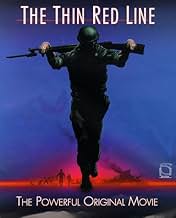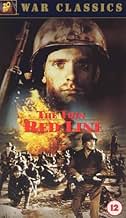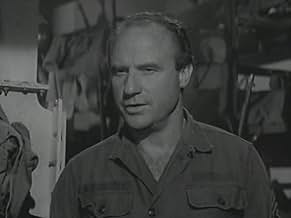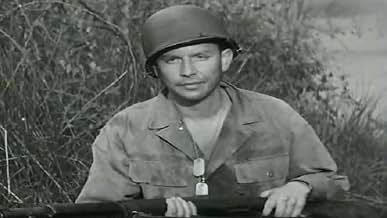Ajouter une intrigue dans votre langueIn Guadalcanal during World War II, a private and his sergeant clash during the heat of battle with the Japanese.In Guadalcanal during World War II, a private and his sergeant clash during the heat of battle with the Japanese.In Guadalcanal during World War II, a private and his sergeant clash during the heat of battle with the Japanese.
- Réalisation
- Scénario
- Casting principal
Bob Kanter
- Fife
- (as Robert Kanter)
Jim Gillen
- Capt. Gaff
- (as James Gillen)
Stephen Young
- Stack
- (as Stephen Levy)
Avis à la une
Like some other commenters, I saw the 1998 version before seeing this version. I had expected a somewhat jingoistic war film, but was surprised that this turned out to be superior to the 1998 remake in every way but one. Of course the one aspect that was lesser was the depiction of graphic violence, and that was only due to the changing times and audience, and modern film effects that can show things more realistically in graphic fashion. However, I do not consider this a positive, but only stating that the technical ability to show graphic violence has improved. I would say that the story in this one is more engaging, more concise and without losing the effect of alienation that both try to convey, and in fact that effect is much more visible here in this depiction. I found the acting to be solid and less melodramatic than the 1998 version, and the soldiers actions all ring true to what would have been going on in WW II at Guadacanal, without hystrionics. It's quite interesting that this version, coming right before the Vietnam era would be cynical about war but also considerably mindful of the necessity of the particular war it depicts and of the need for the soldiers to do as they did. Whereas the post-Vietnam 1998 version is also cynical, yet much more so, showing the military as a bumbling bureaucracy of sorts and attempting to depict the battle as pointless, extending that depiction to the war in general, and it actually is an unstated allegory about Vietnam. I would say that the 1998 film boasts a production group fairly unaware of the overall reality of WW II, and still stuck in the miasma of Vietnam.
The last line in the novel reads as follows:"One day one of their number would write a book about it all, but none of them would believe it, because none of them would remember it that way."
Jones was saying that their is a tendency to (for lack of a better term) gloss over what happened in war, and the way people write about war, and the way people film war, is not at all how veterans remember it.
This film is not really at all what Jones was writing about. The film fails to find any horror in the war-- it fails to show the war as written by James Jones.
It is rather interesting to watch, because it shares many scenes with the Terrence Malick film (which is the far superior work), and it is fun to compare the scenes.
That said, the two actors who play Col. Tall and Stone (Stein in the book, Staros in the Malick film) are both laugh out loud bad, and seem to be completely ignorant of how to effectively portray their characters (Nolte and Koteas, on the other hand, aren't).
But to give the film some credit, it features a great performance by Kier Dullea or 2001: A Space Oddyssey fame, and an interesting one from Jack Warden as Welsh.
I think that the film tries to show the horror, but the production code, the script, or director didn't want to or couldn't figure out how to. I appreciated this film more for what it tried to say than what it actually said or HOW it said it. I would marginally reccommend it, mainly to those unfamiliar with the superior Malick film.
Jones was saying that their is a tendency to (for lack of a better term) gloss over what happened in war, and the way people write about war, and the way people film war, is not at all how veterans remember it.
This film is not really at all what Jones was writing about. The film fails to find any horror in the war-- it fails to show the war as written by James Jones.
It is rather interesting to watch, because it shares many scenes with the Terrence Malick film (which is the far superior work), and it is fun to compare the scenes.
That said, the two actors who play Col. Tall and Stone (Stein in the book, Staros in the Malick film) are both laugh out loud bad, and seem to be completely ignorant of how to effectively portray their characters (Nolte and Koteas, on the other hand, aren't).
But to give the film some credit, it features a great performance by Kier Dullea or 2001: A Space Oddyssey fame, and an interesting one from Jack Warden as Welsh.
I think that the film tries to show the horror, but the production code, the script, or director didn't want to or couldn't figure out how to. I appreciated this film more for what it tried to say than what it actually said or HOW it said it. I would marginally reccommend it, mainly to those unfamiliar with the superior Malick film.
Grim psychological study of two Marines on Guadalcanal, each seemingly trying to top the other in body count of Japanese slain, not for God, country, or to win the war, but for the sheer joy of killing.
Extremely realistic combat sequences coupled with Dullea's excellent portrayal of the on-the-edge-of-madness Pvt. Doll make this one of my favorite war films.
Extremely realistic combat sequences coupled with Dullea's excellent portrayal of the on-the-edge-of-madness Pvt. Doll make this one of my favorite war films.
6PKC
A solid effort hampered by the the filmmaking conventions of that time. Some of the acting is amateurish, and the dialogue stilted. But it does confront the serious moral issues of war, unlike most war movies of that era. The theme is essentially the same as the current version -- that is, how does man endure in war? It presents several models for survival. Many of the scenes are exactly the same as in the 1998 version, though it includes others that are not found in Malick. This attempt focuses more on the relationship between Welsh (Jack Warden) and Doll (Keir Dullea). The music is awful, like something out of a cheesy 50s horror flick. Also, it's amazing how much Guadalcanal resembles the high desert of Southern California. But this is well worth a rent if one has the proper expectations...
James Jones also wrote "From Here to Eternity", and this novel has been filmed several times, last time in 1998 in colour, but the two versions compliment each other. This one is more stringent and poignant in its psychology and characterizations. Jack Warden and Keir Dullea clash from the beginning, they are both close to the thin red line separating sanity from madness, and they appear as rather half mad both of them, although Keir Dullea seems more liable, as he loses control a number of times. Jack Warden's madness is of a different kind, as he rather drives others mad than goes mad himself, and he is the better soldier of the two.
It's about the critical battler of Guadalcanal, when more men were lost than even the Americans and theír ruthless colonel could afford. Although you don't see much of the Japs, the Americans didn't either, as the Japs were experts on ambushes and targeting Americans unawares, they appear as fearsome soldiers indeed. Many Americans have also testified, that Japanese soldiers were the bravest soldiers of all.
It's a brutal and realistic war account from its worst sides, and if you can stand any amount of war atrocities, this is a film for you. If you can't, you had better stick to something nicer with dames. There are only two dames in this film, one in a short flashback, and the other one isn't even a dame, and her appearance is even shorter.
It's about the critical battler of Guadalcanal, when more men were lost than even the Americans and theír ruthless colonel could afford. Although you don't see much of the Japs, the Americans didn't either, as the Japs were experts on ambushes and targeting Americans unawares, they appear as fearsome soldiers indeed. Many Americans have also testified, that Japanese soldiers were the bravest soldiers of all.
It's a brutal and realistic war account from its worst sides, and if you can stand any amount of war atrocities, this is a film for you. If you can't, you had better stick to something nicer with dames. There are only two dames in this film, one in a short flashback, and the other one isn't even a dame, and her appearance is even shorter.
Le saviez-vous
- AnecdotesThe film's title comes from James Jones's novel and, in turn, from an old saying. In the movie, Captain Stone, played by Ray Daley, says, "I remember an old Midwest saying, 'There's only a thin red line between the sane and the mad.' "
The original 'Thin Red Line' refers to the routing of a Russian cavalry charge by the Sutherland Highlanders 93rd (Highland) Regiment during the Battle of Balaklava on 25 October 1854, during the Crimean War.
- GaffesFor some reason the Japanese soldiers are at times are armed with German Schmeisser SMG's.
- ConnexionsFeatured in The 80th Annual Academy Awards (2008)
Meilleurs choix
Connectez-vous pour évaluer et suivre la liste de favoris afin de recevoir des recommandations personnalisées
- How long is The Thin Red Line?Alimenté par Alexa
Détails
- Durée1 heure 39 minutes
- Couleur
- Rapport de forme
- 2.35 : 1
Contribuer à cette page
Suggérer une modification ou ajouter du contenu manquant

Lacune principale
By what name was L'attaque dura sept jours (1964) officially released in Canada in English?
Répondre


























